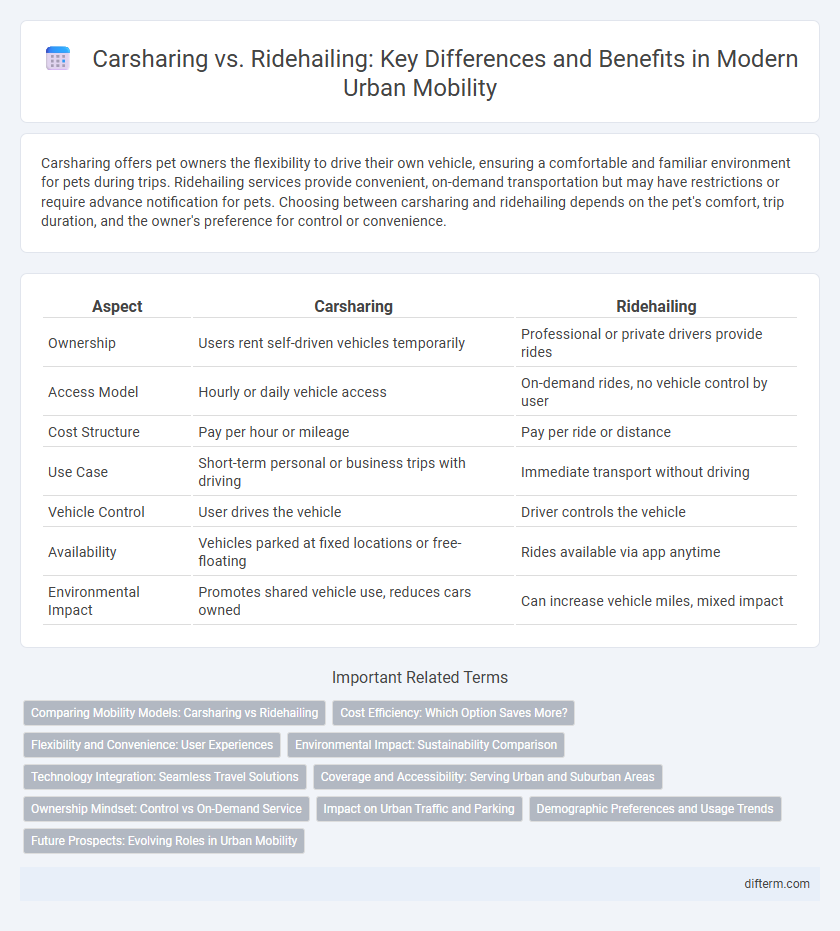Carsharing offers pet owners the flexibility to drive their own vehicle, ensuring a comfortable and familiar environment for pets during trips. Ridehailing services provide convenient, on-demand transportation but may have restrictions or require advance notification for pets. Choosing between carsharing and ridehailing depends on the pet's comfort, trip duration, and the owner's preference for control or convenience.
Table of Comparison
| Aspect | Carsharing | Ridehailing |
|---|---|---|
| Ownership | Users rent self-driven vehicles temporarily | Professional or private drivers provide rides |
| Access Model | Hourly or daily vehicle access | On-demand rides, no vehicle control by user |
| Cost Structure | Pay per hour or mileage | Pay per ride or distance |
| Use Case | Short-term personal or business trips with driving | Immediate transport without driving |
| Vehicle Control | User drives the vehicle | Driver controls the vehicle |
| Availability | Vehicles parked at fixed locations or free-floating | Rides available via app anytime |
| Environmental Impact | Promotes shared vehicle use, reduces cars owned | Can increase vehicle miles, mixed impact |
Comparing Mobility Models: Carsharing vs Ridehailing
Carsharing provides users access to vehicles for short-term use, promoting autonomy and cost-efficiency through hourly or daily rentals, while ridehailing offers on-demand rides via apps connecting passengers with drivers, emphasizing convenience and immediate availability. Carsharing reduces parking demand and supports urban sustainability by encouraging shared vehicle usage, whereas ridehailing contributes to increased vehicle miles traveled and potential congestion but offers flexible point-to-point transport. Understanding these mobility models' distinct operational frameworks and environmental impacts helps cities design integrated transportation systems that balance accessibility, cost, and urban traffic management.
Cost Efficiency: Which Option Saves More?
Carsharing typically offers greater cost efficiency for frequent users by reducing expenses related to car ownership, such as insurance, maintenance, and parking fees, while ridehailing incurs higher per-trip costs due to dynamic pricing and surcharges. Studies indicate an average monthly saving of 30-50% with carsharing compared to ridehailing for daily commuters. Optimizing usage patterns can further maximize savings, especially in urban areas with high ridehailing demand and available carsharing fleets.
Flexibility and Convenience: User Experiences
Carsharing offers users the flexibility to access vehicles on-demand without the need for a driver, allowing for spontaneous trips with complete control over the route and schedule. Ridehailing services provide convenience through door-to-door service, eliminating the need for parking and providing instant rides via smartphone apps. User experiences highlight carsharing's appeal for planned, multi-stop journeys, while ridehailing excels in quick, point-to-point travel with minimal effort.
Environmental Impact: Sustainability Comparison
Carsharing reduces carbon emissions by enabling multiple users to share fewer vehicles, lowering the overall number of cars on the road and decreasing resource consumption. Ridehailing services often increase vehicle miles traveled due to deadheading, contributing to higher greenhouse gas emissions and urban congestion. Studies show carsharing achieves greater sustainability by promoting efficient vehicle use and reducing private car ownership rates compared to ridehailing models.
Technology Integration: Seamless Travel Solutions
Carsharing platforms leverage IoT and mobile apps to provide users with real-time vehicle availability and keyless entry, streamlining the reservation and pickup process. Ridehailing services integrate GPS tracking and AI-driven route optimization to ensure efficient pickups and reduce wait times. Both technologies converge to offer seamless travel solutions by enhancing accessibility, reducing friction, and improving overall user experience in urban mobility.
Coverage and Accessibility: Serving Urban and Suburban Areas
Carsharing services predominantly focus on dense urban areas where short-term vehicle access meets high demand, offering flexible and cost-effective mobility options. Ridehailing platforms provide broader geographic coverage, efficiently serving both urban centers and suburban neighborhoods with on-demand transportation. The integration of ridehailing improves accessibility for residents in less dense regions, complementing carsharing's urban-centric model.
Ownership Mindset: Control vs On-Demand Service
Carsharing promotes a control-oriented ownership mindset by allowing users to access vehicles for extended periods, providing the flexibility to treat cars like their own without the responsibilities of full ownership. Ridehailing emphasizes an on-demand service model, prioritizing convenience and immediate access without any need for vehicle management or maintenance. This fundamental difference shapes user preferences, with carsharing attracting those valuing autonomy and ridehailing appealing to those seeking hassle-free, instant mobility solutions.
Impact on Urban Traffic and Parking
Carsharing reduces urban traffic congestion by enabling multiple users to access a single vehicle, decreasing the total number of cars on the road and demand for parking spaces. Ridehailing services, while convenient, often increase vehicle miles traveled due to empty trips between rides and contribute to curbside congestion by frequent passenger pick-ups and drop-offs. Implementing carsharing programs in dense urban areas can optimize parking utilization and mitigate traffic density more effectively than ridehailing alone.
Demographic Preferences and Usage Trends
Millennials and Gen Z show a strong preference for ridehailing services due to flexibility and convenience, while older demographics lean towards carsharing for cost efficiency and control. Urban residents typically favor ridehailing to avoid parking hassles, whereas suburban users opt for carsharing to reduce ownership expenses. Usage trends indicate ridehailing peaks during weekends and evenings, contrasted by steady, utilitarian carsharing demand throughout weekdays.
Future Prospects: Evolving Roles in Urban Mobility
Carsharing and ridehailing services are set to increasingly complement each other in urban mobility ecosystems, with carsharing emphasizing vehicle access and long-term use while ridehailing focuses on on-demand convenience. Advances in AI-driven fleet management and electric vehicle integration will drive efficiency and sustainability in both models. Urban planning initiatives are expected to support their coexistence, enhancing seamless multimodal transportation networks for future smart cities.
Carsharing vs Ridehailing Infographic

 difterm.com
difterm.com